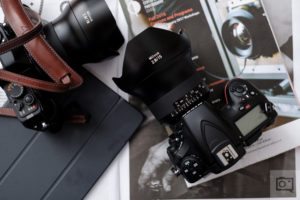
A pair of photographers from Germany are trying to bring the Emil Busch Glaukar 3. 1 portrait lens from 1910 back to life. A portrait lens from 1910 might be coming back to life if two photographers from Germany succeed in a new Kickstarter project—the latest development in the craze to remake vintage optics.
The Glaukar 3. 1 was originally made in Rathenow, Germany by Emil Busch AG for plate camera users, and was considered in its day well corrected for astigmatism, as well as fast with its f/3. 1 aperture. The reinvented lens will share the original’s maximum aperture and three-element symmetrical construction, but will use different glass and lens designs to bring it into line with modern technology, while attempting to retain the characteristics of its ancestor.
Photographers Benedikt Ernst and Firat Bagdu say they have tried to maintain the same angle of view that the Glauker would have delivered on a 13x18cm plate camera so the new version—which is aimed at full frame, APS-C and MFTs users—will have a focal length of 97mm. It will feature a 12-bladed iris, will use glass from the Schott and O’Hara factories, and will be made mostly in Wetzlar, according to the pair.
Here is a set of sample photos captured with a prototype of the lens:
$(document). ready(function() { SampleGalleryV2({"containerId":"embeddedSampleGallery_7756244780","galleryId":"7756244780","isEmbeddedWidget":true,"standalone":false,"selectedImageIndex":0,"startInCommentsView":false,"isMobile":false}) });
The start-up has connections with Meyer Optik Gorlitz, a company that similarly redesigns vintage optics for modern cameras. Meyer says it has helped Emil Busch source manufacturing and parts, so we should expect the glass, iris and barrel to be similar to that of the existing German brand. The engineer for the project is Dr. Wolf-Dieter Prenzel, who is also responsible for many of the Meyer Optik Gorlitz lenses.
The Glaukar’s barrel will be aluminum finished with a brass-effect, and the lens will come in mounts for Nikon, Canon, Sony E, Fuji X, Micro Four Thirds, Leica M and Leica T. Shipping is expected to begin in Summer 2018 and the price is estimated to be around $2,000—though early backers can pre-order by pledging $700 via the Kickstarter page. For more information see the Emil Busch website.
Press Release
Reinventing the Legendary Emil Busch Glaukar 3. 1 Lens
More than 100 years after the Emil Busch Glaukar 3. 1 was introduced as one of the most important lenses of its time, two top German photographers have reinvented this classic as a modern portrait lens that promises to be as innovative as the original. The pair has partnered with well-known optical engineer Wolfdieter Prenzel on this project in which production will mostly take place in Wetzlar, Germany, to ensure the highest quality.
Fashion photographer Benedikt Ernst and portrait photographer Firat Bagdu launched a Kickstarter campaign today to bring the Glaukar 97mm f/3. 1 into the modern age.
The new Glaukar 3. 1 will have the same brass appearance and silhouette as the original but will be constructed from high-end aluminum with a brass-like oxidation, which ensures the durability and mechanical precision of a modern lens. But while the new lens will look very much like the classic, the inside has been redesigned by Prenzel, completely from scratch to meet today’s high-tech demands.
But due to its specially coated lenses the new Glaukar produces a fascinating mixture of sharpness, strong colors and, along with 12 aperture blades, wonderful bokeh effects.
Ernst and Bagdu, whose clients have included Rolls Royce, Redken, Chopard, to name a few, knew what qualities they wanted in a lens. They defined the principles and joined with lens designers and manufacturers in Germany to design the first prototype.
In fact, it was the success of one of their clients, German lens maker Meyer Optik, that inspired them to start their own project. Meyer Optik has even put the pair together with key German camera contacts in Wetzlar to help support the founders.
So, while the pair are a startup, they are backed by years of industry experience.
"We have seen some campaigns in the past where old lenses were brought back for the users of today's cameras and appreciated them, but we wanted to go further and recreate a lens that would otherwise be lost,” Bagdu said. "But at the same time, the quality of the lens must be to the highest standards as well," Ernst added. “Therefore, we are glad that we could ensure cooperation with some leading German firms.
Manufacturing will be done to a large extent by Uwe Weller Feinwerktechnik in Wetzlar, which was formed from the merger of several firms, including the mechanical divisions of Leica Camera and Zeiss-Hensoldt. The partnership with Uwe Weller GmbH will ensure that the high- precision elements of the lens will be produced precisely to Prenzel’s design, which will include the use of top-of-the-line Schott and O'Hara glass.
The exclusive use of Schott and O'Hara glass ensures that the goal of creating the perfect portrait lens is put into practice exactly as intended.
Part of their inspiration came from the legendary Glaukar 3. 1 that pioneer German lens maker Emil Busch introduced in 1910. The original Glaukar was a groundbreaking lens because it corrected for spherical aberration, coma and astigmatism – something that no other lens in daily use could do at the time. Not even Zeiss and its famed lens maker Paul Rudolph had been able to match the Glaukar since their designs required coatings not available at the time.
The modern Glaukar will come in the following mounts:
Nikon
Canon
Sony E
Fuji
Micro Four Thirds
Leica M
Leica T
Lens Specs
Focal length: 97mm
Maximum aperture: 1:3. 1
Aperture range: 1:22
Image circle: 43mm
Field of view: 25°
Electronic contacts none
Closest focusing distance: 1. 5 m
Filter thread: 37mm
Max diameter: length 73mm/80mm (DSLR), approx. 85mm mirrorless
Weight: 410 g
2017-7-20 18:48
















